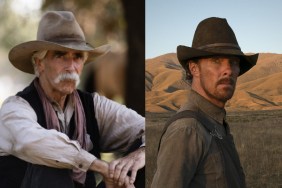Back in April, the first still photo of Sir Anthony Hopkins in character as the matchless Master of Suspense got us even more excited for Hitchcock. When glamour shots of the incorrigible Lindsay Lohan in her Elizabeth Taylor getup debuted last week, they assuaged our fears about her ability to fill the shoes of “One-Shot Liz” until she promptly resumed her characteristic self-destructive behavior off-set. The talented Andre 3000 will perhaps more effortlessly transform into his muse when he tackles Jimmy Hendrix in a much-anticipated biopic, and it’s rumored that Queen fan Katy Perry covets a part opposite Sacha Baron Cohen as Freddie Mercury’s longtime girlfriend Mary Austin.
We can only hope these upcoming productions live up to expectations, that they honor the legacies they’ve been entrusted with. In the meantime, we fondly recall some of the best biographical films ever made, all inspired by the unorthodox life of an artist. Like all true stories should be, each one is as unflinching as it is entertaining.
10. Frida (dir. Julie Taymor, 2002)

Salma Hayek fought valiantly for the lead role in this robust interpretation of the life and work of surrealist painter Frida Kahlo. Kahlo, who often exaggerated her faint mustache and untamed unibrow in stern self-portraits, probably wouldn’t have guessed she’d someday be portrayed by one of the screen’s sexiest women. But Hayek pulled it off, and her Oscar nomination is proof positive that Director Julie Taymor made the right choice. The arguably not-quite-as-sexy Alfred Molina is just as perfectly suited for his part, passionately giving voice to the philandering Communist artist Diego Rivera, who rode a decades-long love rollercoaster with Kahlo through Mexico City and beyond; much of the movie has to do with the couple’s steamy courtship and the turmoil that followed. Kahlo’s colorful renderings of her unrelenting emotional and physical anguish help to transition between scenes in this gorgeous tribute. By the end of the film, we fully understand her deathbed words at the age of 47: “I hope the exit is joyful, and I hope never to return.”
9. Man on the Moon (dir. Milos Forman, 1999)

Professional oddball Andy Kaufman insisted he wasn’t a comedian, though that may be the closest we can hope to get to coming up with an accurate label. His old buddy and prank partner Bob Zmuda prefers instead to consider him a behavioral scientist, but the title doesn’t adequately encapsulate the work of a guy who remained a child until the end and took almost nothing seriously. The gawky goof made an impression on millions with his silly songs, elaborate hoaxes and schizophrenic personality shifts. Though his game was to manipulate audiences by subverting show business norms, his agenda never undercut his remarkable ability to inspire wonderment on the whim of his fancy. Jim Carrey must have been thrilled to bring the legend to life on the big screen in this playful, heartfelt treasure by Miloš Forman (director of the lauded Amadeus). Some fans hold out hope that Kaufman’s final curtain call in 1984 was his most ambitious trick to date, and I count myself among them. (Andy, if you’re reading this, Saturday Night Live could really use your help.)
8. Basquiat (dir. Julian Schnabel, 1996)

Painter-turned-director Julian Schnabel caught flack for this highly subjective rendering of an old friend’s journey from penniless New York City graffiti artist to internationally celebrated golden child. Casting Gary Oldman as a thinly-veiled version of himself in a vital role, Schnabel couldn’t resist dropping in for a cameo and awarding brief appearances to members of his immediate family. Though Neo-Expressionist Jean-Michel Basquiat- rebel son of Haitian and Puerto Rican parents and a tragic member of Club 27- didn’t stick around long enough to provide much retrospective insight on his media image, he was already sufficiently disillusioned by the art and culture machine by the time drugs took his life in 1988. If nothing else, he’d have to admire the sheer amount of creativity and tenderness that birthed this version of his story. Lead actor Jeffrey Wright anchors the wonderfully ethereal love letter from Schnabel to his departed comrade, but David Bowie steals the show as Andy Warhol.
7. Funny Girl (dir. William Wyler, 1968)

Broadway musical adaptations get away with a lot. Employing the versatile magic of plot-advancing, expository, visceral song and dance, they blithely pull off what their traditional narrative counterparts can’t attempt. William Wyler’s Funny Girl follows the career and sexual awakening of proudly deviant Hungarian-Jewish comedian Fanny Brice of the Ziegfeld Follies. It’s probably best known for putting a young Barbra Streisand from Brooklyn on the map, but we should also thank it for paving the way for countless awkward brainy girls whose sense of humor is a bigger asset than the contents of their bikinis. The film’s fun, edgy screenplay showcases the sardonic wit and earnest naivete of its lovable title character, and its sweet emotional moments are as welcome and effective as the madcap hijinks peppered throughout. As a cherry on the pie, Streisand’s astounding pipes remind us of timeless universal truths. After all, people who need people are indeed the luckiest people in the world. Also, don’t rain on her parade, because the sun’s a ball of butter.
6. La Vie en Rose (dir. Olivier Dahan, 2007)

“Thank you life, thank you love! It is true there’s some angels in this city!” said a breathless, trembling Marion Cotillard upon accepting her Oscar statuette for an unforgettable portrayal of songstress Edith Piaf- the Little Sparrow, Voice of France. Experts helped age Cotillard from spunky teenager to a weathered and sickly 47 at the end of Piaf’s punishing battle with liver cancer. The only thing more astounding than the makeup is Cotillard’s self-assured performance. Just bearing witness feels like an honor, and the film’s non-linear style only strengthens the impact of her skill. The beautiful Paris-born actor broke Golden Globe and Academy barriers as the first winner in her categories for a French-language role, also nabbing coveted Cesar and BAFTA Awards in addition to several others. This impressively thorough and layered movie is anchored by Cotillard’s serious investment in telling the story of a tiny woman who united nations with her song.
5. My Left Foot (dir. Jim Sheridan, 1989)

Christy Brown was one of those people who lived a life that makes most of us feel woefully inadequate. An accomplished Irish writer and painter, he suffered from a paralyzing case of cerebral palsy which forced him to channel his creative ideas through the muscles of his toes. This edifying movie powerfully conveys the usefulness of optimism and familial support in the face of impossible odds. Brown’s blue-collar Catholic parents insisted on giving him the same chance that his 13 siblings had at the outset of their lives, and it’s a good thing they knew well enough to do so. Since we all know Daniel Day-Lewis as a ridiculously committed Method actor, it’s no surprise that he remained in character at all times during the shoot. This meant being carted around constantly on-set, his wheelchair lifted by annoyed crew members. He even broke two ribs in the process, due to the posture he was forced to maintain throughout filming. How many other so-called thespians can boast such a sacrifice?
4. The Pianist (dir. Roman Polanski, 2002)

This Roman Polanski masterpiece, based on Władysław Szpilman’s memoir, follows the expert classical piano man through Nazi-occupied Warsaw during his harrowing five-year struggle to stay alive. When a calm radio recital is suddenly interrupted by German ammunition, all of Szpilman’s hopes for peace and resolution are dashed in an instant. As his options dwindle, as he narrowly escapes death time and again while wasting away to skin and bones, our protagonist manages to survive against the odds with the help of strangers and moments of good fortune. All praise and ceremonious recognition for Adrien Brody’s star-making turn was well-deserved. His performance is part of the reason why the lengthy film remains arresting throughout. Polanski can always be counted on for a decidedly non-Hollywood treatment; this is an especially personal film with vivid and striking imagery and sound. It’s one that stays with you, perhaps for much longer than you’d like.
3. Lust for Life (dir. Vincente Minnelli, 1956)

This engaging tale concerns an aimless young man from the Netherlands whose deepest yearning is “to be of use, to work, to bring something to the world.” Vincent van Gogh’s famous letters to his brother Theo provided rich source material for the Irving Stone novel from which this film was adapted, and its script is chock full of profound insights and meditations on the problem of existence. Lushly illustrating the unchanging cycle of the tortured artist from inertia to obsession to inevitable decline, the plot jumps from one seminal moment to the next without ever losing its heart. Kirk Douglas plays the emotionally fragile, mentally unstable post-Impressionist with just the right mix of authenticity and theatricality. Occasionally, his magnetic intensity combines with the bombastic musical score to hurl us into full-on melodrama, but it’s fitting in light of the nature of van Gogh’s work and his harsh stance on auditory appendages.
2. Coal Miner’s Daughter (dir. Michael Apted, 1980)

“Well, I was born a coal miner’s daughter/ In a cabin, on a hill in Butcher Holler/ We were poor, but we had love/ That’s the one thing that daddy made sure of,” sang future country music star Loretta Lynn in 1969. Seven years later, she’d release an autobiography, just four years before witnessing the debut of Michael Apted’s film adaptation while still in her mid-forties. An early bloomer by necessity, the Kentucky native was married to Doolittle “Doo” Lynn at 15 and blessed with a gaggle of screeching children before 20. Doo’s prophetic gift of a cheap guitar was Loretta’s escape from the insanity of home life before launching her into an equally overwhelming career in the music business. This film lovingly charts her heartbreaks and successes in warm tones on vast landscapes, making good use of Sissy Spacek’s pitch-perfect vocals on the soundtrack. This movie has always been a personal favorite; it’s solely responsible for my enduring crush on Tommy Lee Jones, who made a crabby, unfaithful Doo look like quite the charmer.
1. American Splendor (dirs. Shari Springer Berman & Robert Pulcini, 2003)

Underground comic book author and folk philosopher Harvey Pekar worked as a hospital file clerk in Cleveland. By his retirement party at age 62, he’d made eight appearances on Late Night with David Letterman, collaborated with Robert Crumb and many other notable cartoonists, amassed a ton of vintage records and battled lymphoma. He described life as an essentially unwinnable, exhausting war of attrition to be endured. Pekar’s misanthropy and general disappointment spawned the autobiographical realism of the American Splendor series. There’s no telling how many modern artists owe their understanding of confessional fiction to his contributions, whether they know it or not. It’s apropos that this film, which focuses on Pekar’s troubled adulthood and uncomfortable brushes with fame, was written and directed by a pair of documentarians (Shari Springer Berman and Robert Pulcini). Intercutting Paul Giamatti’s extraordinary performance with down-to-earth interviews with Pekar and his wife, splicing in breathtaking monologues and archival footage of pivotal on-screen moments in the artist’s career, they gave us something transcendent.






